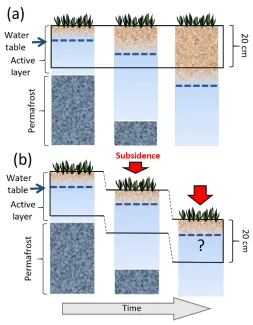Model-data Comparison Highlights Overlooked Processes in Models of Soil Moisture and Hydrology
- Investigate and compare soil moisture projections for eight land models with permafrost processes and highlight the causes and impacts of ground subsidence on soil moisture projections.
- Models commonly used to represent carbon loss from tundra ecosystems were analyzed, for the first time, to identify assumptions underlying soil moisture calculations.
- Thawing of permafrost can lead to an increase in the hydraulic conductivity of the soil column, thereby enhancing redistribution of water in the soil column.
- Large discrepancies in projections remain as the current generation of models substantially differ in how they represent soil thermal processes and ground subsidence as a result of permafrost thaw.
- Models must be further evaluated to further quantify the uncertainty associated with these deficiencies.
Andresen, CG, DM Lawrence, CJ Wilson, AD McGuire, C Koven, K Schaefer, E Jafarov, S Peng, X Chen, I Gouttevin, E Burke, S Chadburn, D Ji, G Chen, D Hayes, and W Zhang. 2020. Soil moisture and hydrology projections of the permafrost region – a model intercomparison. The Cryosphere, 14:445–459. https://doi.org/10.5194/tc-14-445-2020
This research was supported by the Director, Office of Science, Office of Biological and Environmental Research of the US Department of Energy under Contract No. DE-AC02-05CH11231 as part of the Next-Generation Ecosystem Experiments (NGEE Arctic) project.
For more information, please contact:
Christian Andresen


